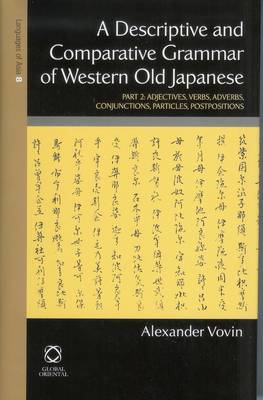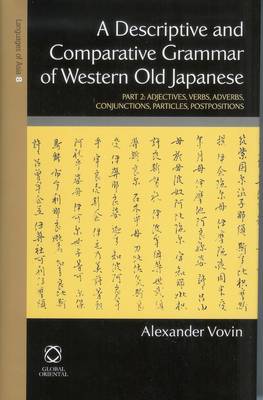
- Afhalen na 1 uur in een winkel met voorraad
- Gratis thuislevering in België vanaf € 30
- Ruim aanbod met 7 miljoen producten
- Afhalen na 1 uur in een winkel met voorraad
- Gratis thuislevering in België vanaf € 30
- Ruim aanbod met 7 miljoen producten
Zoeken
A Descriptive and Comparative Grammar of Western Old Japanese
Part 2: Adjectives, Verbs, Conjunctions, Particles, Postpositions, Indexes
Alexander Vovin
€ 360,45
+ 720 punten
Uitvoering
Omschrijving
Together with Part 1 of the same grammar (Sources, Script and Phonology, Lexicon and Nominals), this two-volume set represents the most detailed and exhaustive description ever done of any language, including Japanese of the Old Japanese language of the Yamato region during the Asuka Nara period. It presents hundreds of examples drawn not only from the major Old Japanese texts such as the Man'yoshu, the Senmyo, the Kojiki kayo and the Nihonshoki kayo but also from all minor extant texts such as the Fudoky kayo, the Bussoku seki ka, and others. It also includes comparative material from Eastern Old Japanese once spoken in the area roughly corresponding to present-day southern Chubu and Kanto regions, as well as from Ryukyuan and occasionally from other surrounding languages. Part 2 is accompanied by exhaustive and cumulative indexes to both volumes, including separate indexes on all grammatical forms described, linguistic forms, personal names, as well as an index of all Old Japanese texts that are used as examples in the description.
Specificaties
Betrokkenen
- Auteur(s):
- Uitgeverij:
Inhoud
- Aantal bladzijden:
- 992
- Taal:
- Engels
- Reeks:
- Reeksnummer:
- nr. 8
Eigenschappen
- Productcode (EAN):
- 9781905246823
- Verschijningsdatum:
- 18/12/2008
- Uitvoering:
- Hardcover
- Formaat:
- Genaaid
- Afmetingen:
- 147 mm x 218 mm
- Gewicht:
- 1338 g

Alleen bij Standaard Boekhandel
+ 720 punten op je klantenkaart van Standaard Boekhandel
Beoordelingen
We publiceren alleen reviews die voldoen aan de voorwaarden voor reviews. Bekijk onze voorwaarden voor reviews.











